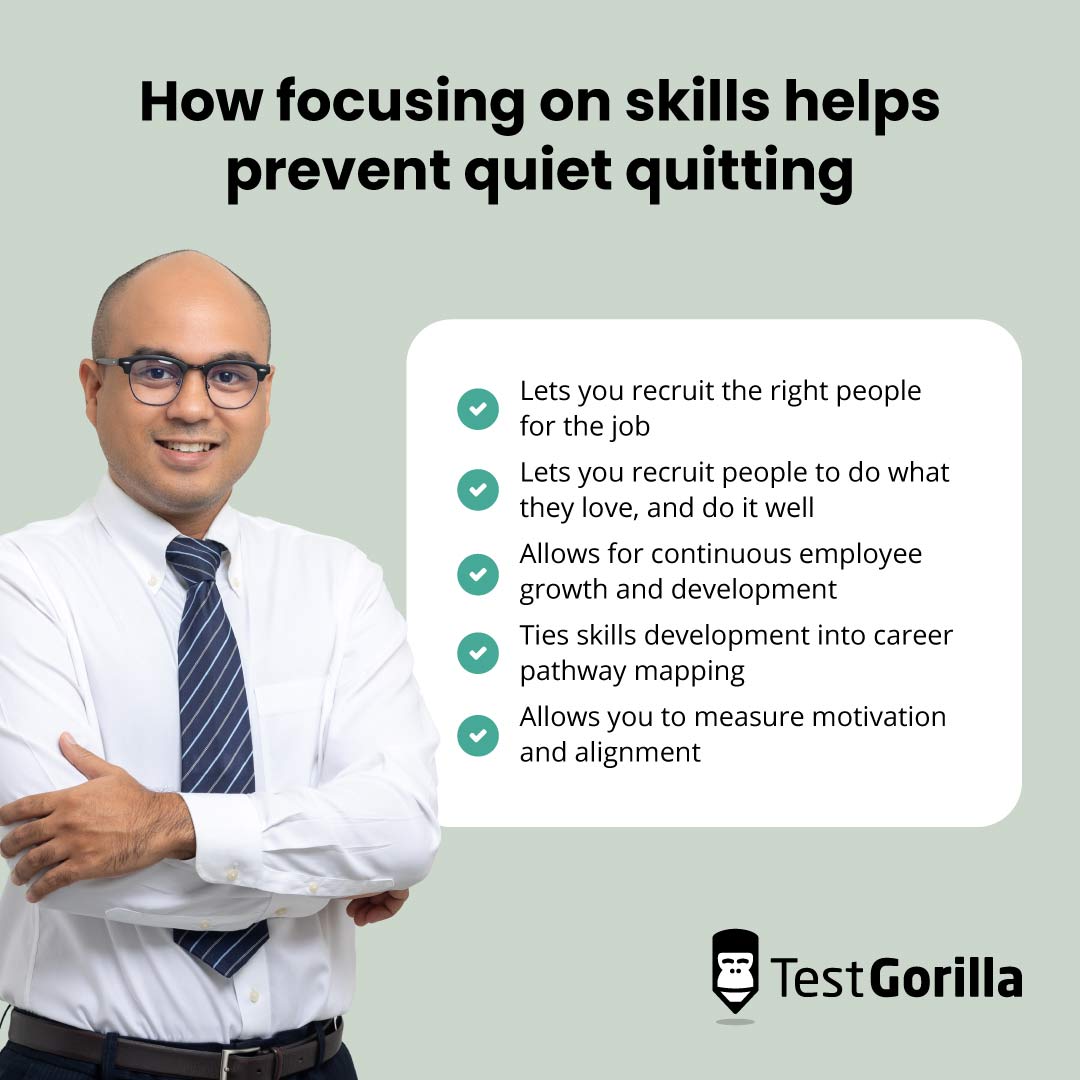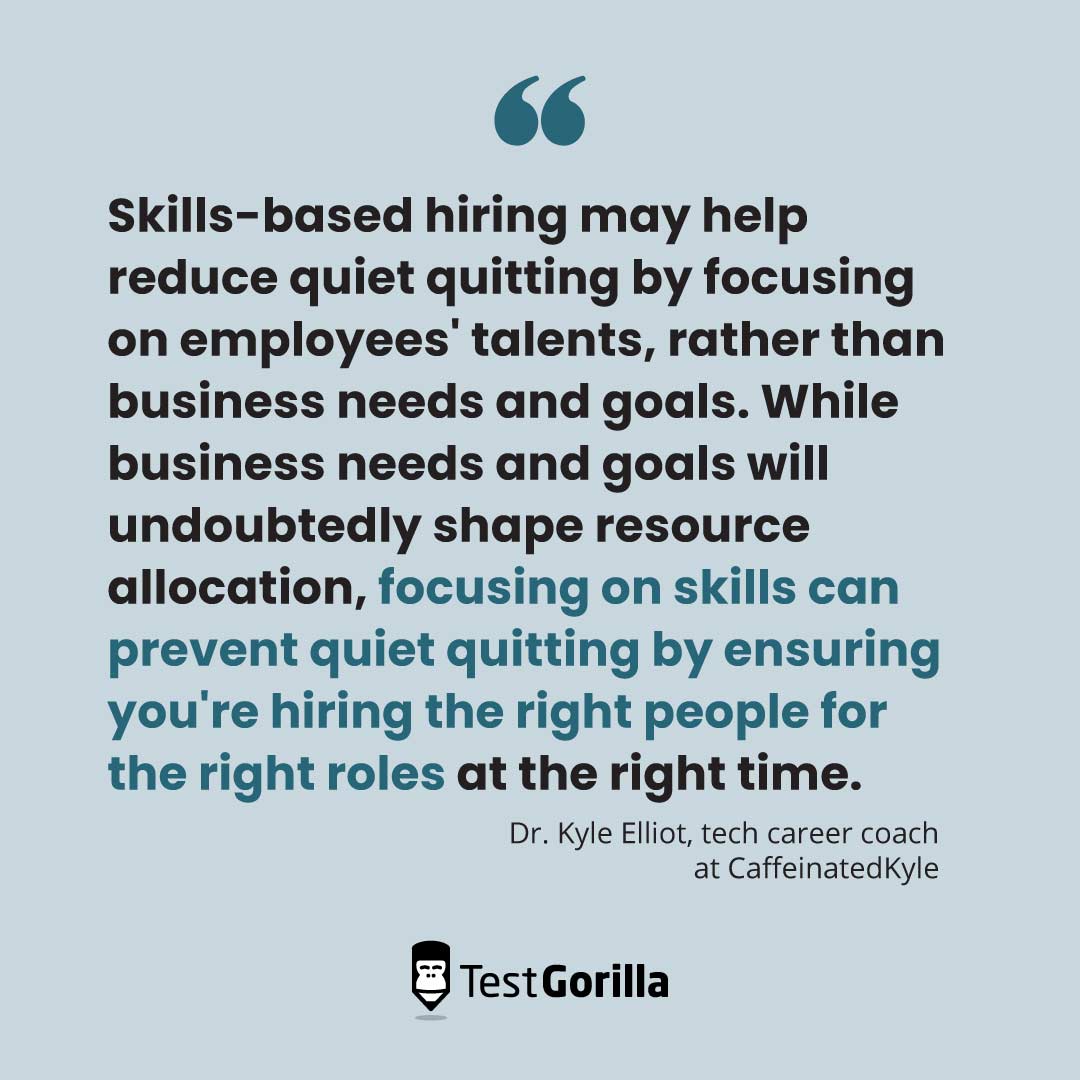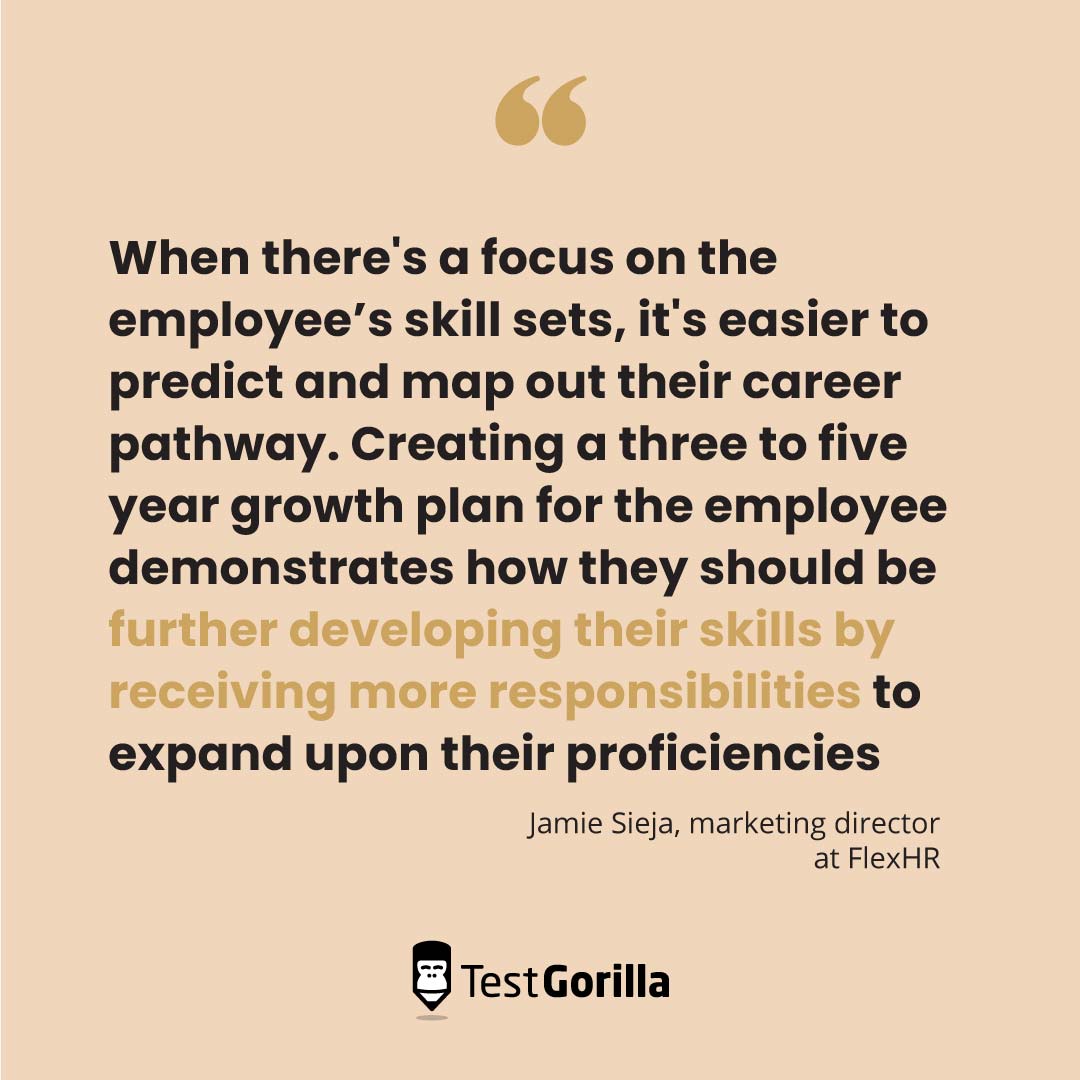Skills don’t quit: How skills-based hiring helps prevent quiet quitting
According to Gallup, 50% of the US workforce alone are “quiet quitters," showing up to work and doing the bare minimum.[1] This detachment from work has huge implications for productivity, company performance, and employee satisfaction. Especially as, in parallel, HR managers say the needle isn’t moving on employee engagement.[2]
However, when you focus on skills-based hiring and regular skills testing and development for existing employees, you can increase engagement and get the best person for the role.
In this article, you'll learn how this approach involves a shift away from assessing candidates through outdated methods like resumes and degrees. Instead, talent assessments focus on talents, strengths, and skills, both those that are innate and those that can be taught.
We’ll also look at how skills-based hiring ties into career transparency and career mapping to boost employee engagement and retention.
How quiet quitting impacts organizations and employees
Having a workforce that isn't delivering or living up to its potential can harm your business.
When employees engage in quiet quitting, they may not outwardly express their dissatisfaction or disengagement. However, they gradually withdraw their effort, commitment, and productivity.
This can have serious consequences for both your business and employees: When employees are no longer fully invested in their work, they don't make the same effort. Additionally, they might not go the extra mile to deliver high-quality results. This can result in missed deadlines, decreased output, and lower overall performance, ultimately affecting your bottom line.
Quiet quitting can also create a negative atmosphere and affect the motivation and morale of other team members. The lack of enthusiasm and progress toward shared goals can harm teamwork, collaboration, and overall team and company cohesion.
"Quiet quitting is an opportunity for organizations to assess their culture and see what's working, as well as what's not, to motivate their employees. Another impact of quiet quitting is on fellow coworkers who may be required to pick up the additional slack, which can lead to burnout."
– Dr. Kyle Elliot, tech career coach at CaffeinatedKyle.
Employee satisfaction and engagement
According to Gallup, companies that focus on culture and wellbeing have higher employee engagement.[3] This means companies that aren't watching out for these factors are more likely to experience quiet quitting.
A lack of overall engagement can lead to quiet quitting, which further negatively impacts engagement and motivation.
Disengaged employees no longer find their work meaningful or fulfilling, resulting in lower employee satisfaction and less desire to contribute.[4] This can even extend into the more naturally engaging aspects of your company culture, like resource groups or team-building activities and outings.
Over time, you start to see a domino effect: One employee disengaging can affect others and have a negative impact on morale across the team and company.
Productivity
Engaged employees are more involved in and enthusiastic about their work and workplace, which increases the quality of their output, productivity, and job performance.[3]
Quiet quitters, on the other hand, limit their efforts to the bare minimum, avoiding any additional contributions that could benefit the business or their teammates. Research shows that 46% of quiet quitters don't want to do more work than they're compensated for, while 35% don't believe it will benefit their career if they do.[4]
Impact on managers
The phenomenon of quiet quitting and an overall drop in employee engagement mean there's a growing disconnect between leadership and employees.[1]
Managers aren't immune to the domino effect of quiet quitting.
With quiet quitting, a team's reduced effort and lack of motivation can result in lower productivity levels. This puts added pressure on leaders to find ways to compensate for the shortfall and meet targets or deadlines.
Quiet quitting also often involves a lack of open communication about dissatisfaction or disengagement. This makes it hard for managers to accurately assess the performance of those employees and provide constructive feedback. This also makes it challenging for managers to address performance issues or recognize and reward high-performing employees.
It's up to leadership teams to engage their teams – and reduce quiet quitting – because leaders account for a 70% variance in employee engagement.[5] This means leaders are mostly responsible for how employees experience their work, and they have the ability to improve it.
Impact on company culture
When employees quietly quit, they often withdraw from collaborative efforts and team building, which blocks teamwork and synergy. This can create silos, communication gaps, and a lack of cooperation within teams and across departments.
Additionally, employees who feel unfulfilled or undervalued are more likely to seek opportunities elsewhere. A high turnover rate often harms company culture since frequent departures negatively impact team dynamics and cohesion. This also results in increased recruitment and training costs for the company, as well as the loss of valuable skills, knowledge, and experience.
Now that you know how quiet quitting can negatively impact your business and employees, let's take a look at how to prevent it. Below, we make the case for skills-based hiring, and how it can lead to a more engaged workforce.
How focusing on skills helps prevent quiet quitting
Skills-based hiring involves assessing a candidate based on their skills rather than their qualifications, experience, or connections.
According to our 2022 State of Skills-Based Hiring report, hiring for skills leads to a better match between employees and their roles. This means employees are happier, stay longer, and find more purpose in their work, which helps prevent them from quietly quitting on the job.
Here are some other ways focusing on skills can help prevent quiet quitting:
Lets you recruit the right people for the job
By focusing on skills in recruiting, you get access to a wider pool of candidates who haven't followed traditional education or career pathways. This helps level the playing field for diverse talent by opening up opportunities to those from varied backgrounds who have the right skills.
Additionally, with talent assessments and take-home assignments, you get a much better feel for a candidate's potential success in the role. On-the-job simulations also give the candidate the opportunity to understand if it's the right job for them. This helps prevent people who aren't the right fit from making it through the application and interview process.
Below are some talent assessments you can use to spot both innate and teachable skills.
Culture add test: Determine a candidate's ability to add to company culture.
Critical thinking test: Identify candidates who can evaluate information and make sound judgments using analytical skills.
Problem solving test: Determine a candidate's ability to use analytical skills to evaluate and respond to complex situations.
Intermediate math test: Find candidates who can work well with numbers.
Dr. Kyle Elliot, tech career coach at CaffeinatedKyle, says: "Skills-based hiring may help reduce quiet quitting by focusing on employees' talents, rather than business needs and goals. While business needs and goals will undoubtedly shape resource allocation, focusing on skills can prevent quiet quitting by ensuring you're hiring the right people for the right roles at the right time."
Pro tip: Use a skills-based approach to hiring and talent assessment software to help you spot innate skills and those you can teach. This will help you develop, reskill, and upskill your talent to stay competitive and agile.
Lets you recruit people to do what they love, and do it well
Skills-based hiring helps you filter out candidates who aren't suitable for the position. This lets hiring managers spend more time with more promising candidates.
Once you’ve assessed a candidate’s skills, take the time to ask the right questions to dig deeper and look beyond their abilities. For example, use the interview to assess their passion for their work and your company's mission, and find out what they want to know about the role. This helps both you and your candidates decide whether they’re the right fit and if they'll thrive in the role.
This approach, combined with a focus on skills, may be one reason why 72.1% of people who were hired using skills-based hiring methods are happy in their roles.
When employees are in the right roles, aligned with your company culture, and love what they do, it's easier to keep them engaged. This creates a positive feedback loop of individual and company success: You get happier employees, an increase in productivity, and better ROI on hiring costs when people stay longer.
This is especially true considering 92.7% of companies that use a skills-based approach to hiring see a reduction in mis-hires. Since a mis-hire can cost 24x an employee's annual salary, this means huge savings on recruitment, including time, energy, and resources.
Allows for continuous employee growth and development
During onboarding and beyond, you can use talent assessments for ongoing skills development to assess current skills and identify gaps and areas for improvement. This makes it easier to hire and promote from within, which improves internal mobility and lets you hold on to key skills and talent by retaining and rewarding them.
Considering only 25% of employees feel strongly that they're learning enough to progress in their jobs, focusing on employee growth and development is crucial to increase engagement and retention.[6]
Regular skills-based testing can help you measure employee progress, spot skills gaps, and show your people that you're taking their professional development seriously. This lets you keep a healthy talent pipeline of hungry candidates who simply want the opportunity to grow with your company.
Moreover, younger generations like Gen Z have high expectations when it comes to selecting an employer, listing growth and development opportunities as their second highest priority after work-life balance.[7] So using skills-based hiring makes your company more attractive to this demographic.
Ties skills development into career pathway mapping
According to Jamie Sieja, marketing director at FlexHR: "When there's a focus on the employee’s skill sets, it's easier to predict and map out their career pathway. Creating a three to five year growth plan for the employee demonstrates how they should be further developing their skills by receiving more responsibilities to expand upon their proficiencies."
Showing people where they could be in X years, and which skills they need to develop to get there, means they're more likely to stick with your organization and stay engaged in their current role.
Talent assessments can help you map out a career development plan by showing you where employees' strengths lie and which skills they need to achieve their goals. This gives everyone involved a clear understanding of what an employee brings to the table in addition to their untapped potential, which helps motivate them to do their best work and improve.
As part of skills development, you can use microlearning to focus on one topic or skill at a time and avoid overwhelming your team.
The best insights on HR and recruitment, delivered to your inbox.
Biweekly updates. No spam. Unsubscribe any time.
Allows you to measure motivation and alignment
As well as using skills-based talent assessments to tie skills development into career pathway mapping, they help you understand how motivated an employee is about reaching their goals. They do this by letting you assess their level of progress in developing the skills they need.
Skills tests like TestGorilla’s Motivation test also let you measure a candidate's engagement during recruitment. This includes the factors that are likely to affect them and their alignment with your company ethos, giving you a clear picture of the type of employee you're hiring, and whether they're prone to low engagement and motivation.
Skills-based hiring: Stop quiet quitting before it starts
Quiet quitting – when employees remain physically present but mentally disengaged – isn’t an individual problem: It affects your whole team and company.
One demotivated employee doing the bare minimum affects others, leading to an overall drop in engagement and productivity and negatively impacting team dynamics and company culture.
You can prevent quiet quitting by hiring people who are the right fit for their role and love what they do.
By focusing on skills rather than resumes during hiring, you can better select individuals who have the necessary skills, strengths, and abilities to excel in their roles and stick around for the long haul. This approach lowers the risk of employees feeling unfulfilled or disengaged and helps you win the talent war.
When you use talent assessments to attract and hire motivated people, you get better employee performance, improved quality of work, and reduced turnover, absenteeism, and lateness.
Prioritizing skills-based hiring lets you create a motivated, productive workforce that’s aligned with your company's goals, culture, and values. This benefits employees by allowing them to leverage their strengths, develop their skills, and reach their goals, leading to a more harmonious and successful workplace.
Want more engaged employees? Skills-based hiring helps you get motivated talent for every role.
Download the 2022 State of Skills-Based Hiring report to learn more.
Sources
"Is Quiet Quitting Real?" (2023). Gallup. Retrieved on June 30, 2023. https://www.gallup.com/workplace/398306/quiet-quitting-real.aspx
“‘The needle is not moving’: HR must rethink employee engagement, SHRM speaker says” (2023) HRDive. Retrieved on July 5, 2023. https://www.hrdive.com/news/the-needle-is-not-moving-hr-must-rethink-employee-engagement-shrm-talent/648296/
"U.S. Employee Engagement Slump Continues." (2022). Gallup. Retrieved on July 3, 2023. https://www.gallup.com/workplace/391922/employee-engagement-slump-continues.aspx
"1 in 4 of workers are ‘quiet quitting,’ saying no to hustle culture." (2023). Resume Builder. Retrieved July 3, 2023. https://www.resumebuilder.com/1-in-4-of-workers-quiet-quitting-saying-no-to-hustle-culture/
"How Influential Is a Good Manager?" (2021). Gallup. Retrieved July 3, 2023. https://www.gallup.com/cliftonstrengths/en/350423/influential-good-manager.aspx
"The State of Collaboration Report: Our top 5 findings." (2022). Howspace. Retrieved July 3, 2023. https://howspace.com/blog/state-of-collaboration-report-top-findings/
"2023 Gen Z and Millennial Survey." (2023). Deloitte. Retrieved July 3, 2023. https://www.deloitte.com/global/en/issues/work/content/genzmillennialsurvey.html
You've scrolled this far
Why not try TestGorilla for free, and see what happens when you put skills first.

















